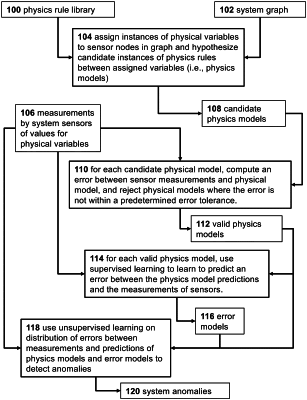| CPC F24F 11/38 (2018.01) [G06F 17/18 (2013.01); G06N 3/08 (2013.01); G06N 3/088 (2013.01); G16Y 40/10 (2020.01); G16Y 40/20 (2020.01)] | 5 Claims |

|
1. A method for detecting anomalies in a physical system comprising devices, the method comprising:
storing in a memory storage device a process graph representing the physical system, wherein the process graph comprises nodes and edges connecting the nodes;
wherein each of the nodes of the process graph represents a corresponding device of the devices of the physical system and each of the edges of the process graph represents a causal physical influence between a pair of the devices, wherein the devices comprise physical assets and sensors, where the sensors are configured to measure physical quantities of the physical system;
storing in the memory storage device physics rules comprising definitions of physical variables, functional relationships between the physical variables, and specifications of physical dimensions for the physical variables;
generating by a processor from the physics rules and the process graph a set of multiple candidate physics models, wherein each of the multiple candidate physics models comprises a physics rule selected from the physics rules and an assignment of each variable of the physical variables of the physics rule to a sensor node of a set of sensor nodes of the process graph, wherein each variable and the assigned sensor node have the same physical dimension;
measuring by the sensors of the physical system values of the physical variables;
receiving by the processor sensor data comprising the values of the physical variables measured by the sensors;
rejecting by the processor a subset of the multiple candidate physics models to produce a subset of valid physics models, where the rejected subset of the multiple candidate physics models is determined by
(i) computing for each candidate physics model of the multiple candidate physics models
(a) predicted values of the candidate physics model by applying the candidate physics model to sensor data of a first subset of sensors associated with the candidate physics model and
(b) an error between the sensor data of a second subset of sensors of the candidate physics model and the predicted values of the candidate physics model, and
(ii) comparing the error with a predetermined error tolerance;
for each valid physics model of the valid physics models, using supervised learning by the processor to train a machine learning model to predict an error between predicted values of the valid physics model and the sensor data;
for each valid physics model of the valid physics models, calculating by the processor
(i) predicted sensor measurements from the valid physics model and
(ii) the error predicted by the machine learning model;
for each valid physics model of the valid physics models, using unsupervised learning on a distribution of error between the predicted sensor measurements and the sensor data to detect anomalies of the physical system, wherein an anomaly corresponds to an error between the predicted sensor measurements and the sensor data exceeding a predetermined error threshold;
reporting to a user the detected anomalies of the physical system.
|